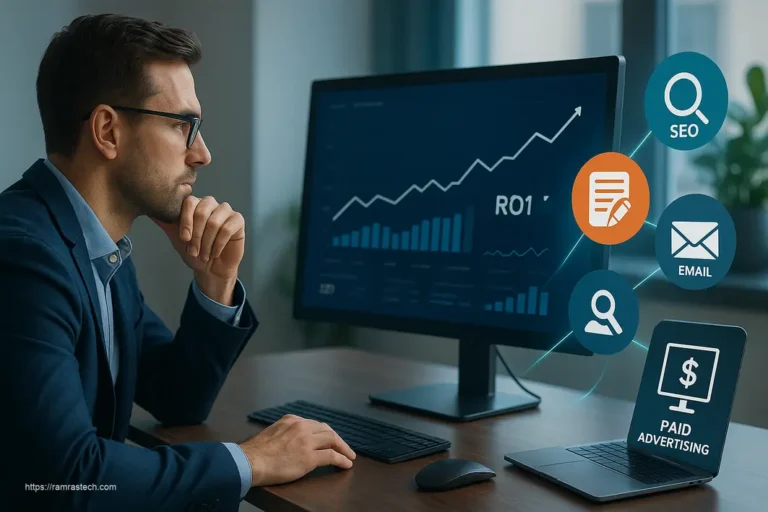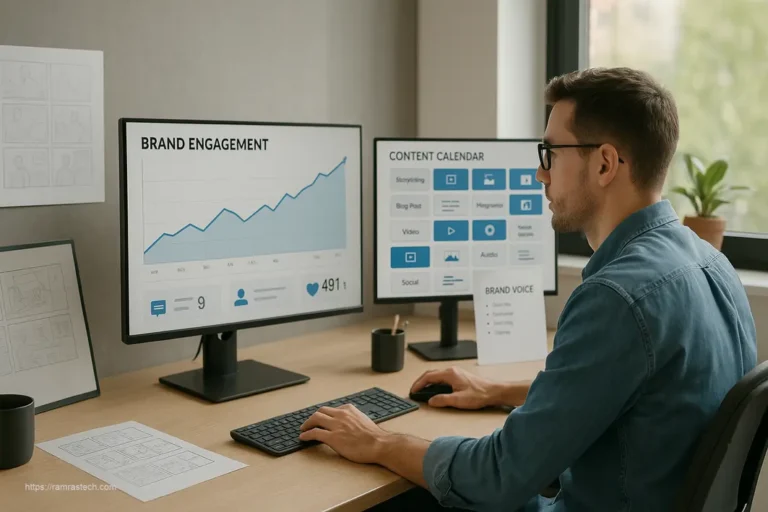How to Master LinkedIn Strategy for Business Success in 2025

How to Master LinkedIn Strategy for Business Success in 2024
LinkedIn has evolved from a simple professional networking site to become a powerhouse business platform. The platform now has over 900 million users who actively engage in B2B transactions worth billions annually. Many businesses still struggle to use its full potential.
Our team has spent years fine-tuning our LinkedIn strategy for businesses. We found that there was more to success on this platform than regular posting and connection building. The platform’s recent changes in 2024 have helped our complete LinkedIn marketing strategy grow substantially.
This piece outlines our proven methods to become skilled at using LinkedIn in 2024. You will learn about the latest algorithm changes and advanced content strategies. These insights will help turn your LinkedIn presence into a powerful engine that propels business development.
Understanding LinkedIn’s 2024 Algorithm Changes
LinkedIn’s algorithm changed radically throughout 2023. These changes have transformed how businesses should use the platform in 2024. Let’s break down these changes and what they mean to your linkedin strategy for business.
Key algorithm updates and their effect
LinkedIn launched major algorithm updates in June 2023. These updates changed content visibility patterns dramatically. Our analysis shows that overall reach has decreased by 35%. Engagement dropped by 20% compared to the previous year [1]. The platform made these changes to achieve two main goals:
- Knowledge-sharing content and professional expertise became priorities
- Users who already know each other now have stronger connections [1]
New ranking factors to think about
LinkedIn now assesses content through three main areas:
1. Content Quality and Relevance
The first 60 minutes after posting affect your content’s momentum [2]. Posts with 900-1,200 characters work best [2]. This happens especially when they share industry expertise.
2. Engagement Patterns
User interaction with content has changed by a lot. Long comments (more than 15 words) now matter twice as much as short responses [3]. On top of that, video content has gained popularity again. LinkedIn Live generates 12x more engagement than regular video posts [3].
Adapting your strategy to algorithm changes
Our experience with these changes reveals several shifts in content performance. These shifts should shape your linkedin marketing strategy:
- Content Format Effect:
- Text + image posts make up 48% of all successful content [2]
- Carousel posts show a 45% decline in reach since mid-2023 [2]
- Native video posts between 1-2 minutes show the best results [2]
- Network Dynamics:
LinkedIn pages grow new followers 9x faster after reaching 150 followers [4]. Building a strong original following becomes vital to long-term success.
The platform’s treatment of external links stands out as the biggest change. These links now see a 25-35% drop in reach [3]. The solution? Post your content directly on LinkedIn and add links in the comments.
Developing a Data-Driven LinkedIn Strategy
The digital world needs evidence-based thinking to create a successful LinkedIn strategy for business. Our experience shows that measuring the right metrics makes a real difference in getting results that matter.
Setting measurable LinkedIn KPIs
Good KPIs should be specific, measurable, and directly tied to business objectives [5]. The most effective LinkedIn KPIs has:
- Follower growth rate
- Engagement rate (likes, comments, shares)
- Conversion rate
- Click-through rate (CTR)
- Cost per conversion
These metrics should arrange with our overall marketing goals. To cite an instance, businesses that focus on lead generation see better results when they connect website tag conversions. This helps them understand how members move through the sales funnel [2].
Using LinkedIn Analytics effectively
LinkedIn Analytics gives powerful insights through two main areas. The Page Admin view lets us track performance through Search Appearances, Page Visitors, New Followers, and Post Impressions [6]. The detailed analytics section teaches us more about Content, Visitors, Followers, and Leads.
Our LinkedIn marketing strategy depends on demographic analysis. We focus on:
Visitor Demographics: The job functions, company sizes, and industries of our page visitors help us create better content [6].
Engagement Metrics: Reactions, comments, and reposts show our content’s value and boost visibility in the algorithm [6].
Implementing tracking and reporting systems
Our detailed tracking system combines multiple data-sharing methods to give the most accurate picture of performance [2]. We use:
Website Tag Implementation: LinkedIn Insight Tag helps us capture page visits and CTA clicks [2].
Conversion Tracking: This shows how our ads create conversions [7]. Connecting conversions to campaigns helps our ads find more conversions quickly [2].
Regular Data Analysis: Daily or weekly data uploads ensure accurate reporting [2]. This regular monitoring helps us adjust our strategy based on performance metrics.
These tracking systems measure key metrics like cost per conversion and return on ad spend [2]. This gives us clear visibility into campaign effectiveness and areas we can improve.
Leveraging LinkedIn’s Advanced Features
Our LinkedIn strategy got a major boost when we found that mastering advanced features gives us an edge over competitors. Let me share three meaningful tools that revolutionized our approach.
Maximizing LinkedIn Sales Navigator
Sales Navigator is the life-blood of our LinkedIn marketing strategy that helps us connect with decision-makers effectively. The platform has over forty filters to find new leads, including job title, function, geographic location, and seniority level [8].
Sales Navigator stands out because it lets us manage our whole book of business in one place. We can upload up to 1,000 accounts simultaneously [9], which makes tracking and participating with potential clients easier. The buyer intent data and relationship explorer features are a great way to get the best path to connect with prospects.
Utilizing LinkedIn Live and Events
LinkedIn Live is a game-changer that transforms engagement completely. Our data shows that live video generates 12x more engagement than regular video posts [10]. Your profile needs more than 150 followers and a history of following professional community policies [11] to qualify for LinkedIn Live.
Our soaring win with LinkedIn Live strategy has sections on:
- Scheduling events 2-4 weeks in advance
- Streaming for 15 minutes to 2 hours to optimize engagement
- Using third-party broadcasting tools like StreamYard or Restream
- Downloading recordings to create highlight clips for future content [12]
Implementing LinkedIn Showcase Pages
Showcase Pages are vital extensions of our main company page that create targeted experiences for distinct audience segments. These pages help us:
Drive Focused Engagement:
We deliver content that genuinely interests specific target audiences [8]. Each Showcase Page can have its unique voice and esthetic that arranges with particular aspects of our brand.
Improve Discovery:
Showcase Pages often appear in LinkedIn search results and guide users back to our main company page [8]. A single company LinkedIn page lets us create up to 10 showcase pages [8], giving us room to highlight different aspects of our business.
Each Showcase Page needs an unambiguous name, clear purpose statement, relevant SEO keywords, and strong visual impact [13] to get optimal results. This approach helps us segment our audience effectively while keeping a clean, organized company presence on LinkedIn.
Optimizing Your LinkedIn Business Profile
A well-optimized LinkedIn business profile builds the foundation of any successful linkedin strategy for business. Our research shows that profiles with complete information receive 30% more weekly views [1]. This makes optimization vital for visibility and getting people to participate.
Technical SEO for LinkedIn profiles
LinkedIn SEO needs more than simple profile completion. The platform ranks profiles based on relevance scores [1]. Our visibility improves when we focus on:
- Keyword placement in critical sections
- Strategic use of industry-specific terms
- Custom URL optimization
- Quality backlink building
- Profile completion metrics
Research shows that profiles with professional photos receive up to 21 times more views [1]. This proves how visual elements play a vital role in technical optimization.
Profile optimization checklist
Our testing has led to a results-driven checklist that works. Here’s what we do:
- Customize your LinkedIn URL to improve searchability [14]
- Update all contact information and website links
- Create a compelling headline with relevant keywords
- Write a detailed “About” section (using all 2,000 available characters) [15]
- Add media content to showcase work examples
- List relevant skills and endorsements
Profiles with 100% completion status rank better in search results [1].
Advanced branding techniques
Our advanced branding strategy creates a unified professional image. Strong branding on LinkedIn needs more than visual elements. Companies with complete information grow followers 9x faster after reaching 150 followers [16].
Visual Optimization:
High-quality images against plain backgrounds work best for profile photos [1]. Compelling banner images tell our brand’s story. These elements create strong first impressions.
Content Integration:
Media content placed throughout different sections makes profiles more effective. We use presentations, videos, and case studies to show our expertise. Our uploaded content matches our brand voice and supports our linkedin strategy for business.
These optimization techniques have improved our profile’s visibility and engagement rates. The secret lies in keeping all profile elements consistent while updating content to reflect current offerings and achievements.
Implementing Advanced Content Strategy
A successful LinkedIn strategy needs effective content at its core. Our testing and analysis led us to develop a smart approach to content optimization that delivers real results.
Content performance metrics
Our LinkedIn marketing strategy depends on tracking metrics that matter. We found that clickthrough rate (CTR) is a significant way to measure content success and shows how well we stop the scroll [17]. Our content’s performance improves by tracking:
- Share count and social engagement
- Subscription and email opt-in rates
- Company engagement metrics
- Quality reach and attention metrics
- Brand awareness indicators
Data shows that quality-based marketing inputs directly connect to financial output [17]. Companies using data analytics for content optimization see a 20% increase in ROI compared to those who don’t [4].
AI-powered content optimization
We transformed our content approach with AI tools that analyze big amounts of up-to-the-minute data analysis. These tools spot patterns and trends that human analysis would miss [18]. Our process involves:
- Investing in specialized AI platforms for content analytics
- Monitoring performance through complete dashboards
- Building teamwork between marketing and data teams
- Changing messages based on real-time insights
Brands can handle large content volumes better with AI-powered optimization [18]. The tools study engagement metrics like click-through rates and social media interactions. They suggest changes when certain phrases or visuals don’t perform well [18].
Cross-platform content integration
Research shows 73% of consumers interact with brands on multiple channels [4]. This makes platform integration vital. Content partnerships work best with clear goals and consistent communication across platforms [19].
Our content adapts across different platforms while keeping the core message intact. The B2B Institute’s research reveals that memorable creative content can generate 10-20X more sales for a company [20].
Our content strategy maintains a balanced mix of types. We share four pieces of relevant content written by others for every self-serving post [21]. This helps us keep engagement high while building credibility across platforms.
These advanced content strategies improved our engagement metrics significantly. Our data confirms that individual-specific experiences in marketing campaigns lead to higher conversion rates [4]. AI-driven optimization helped increase marketing effectiveness by 25% [4].
Mastering LinkedIn Advertising
Becoming skilled at paid advertising on LinkedIn is vital to our LinkedIn strategy for business. Our team has developed effective approaches that deliver results through testing and optimization.
Advanced targeting techniques
LinkedIn’s professional targeting capabilities provide unmatched precision to reach decision-makers. Our targeting strategy prioritizes these professional attributes:
- Job Functions and Titles: Target specific roles while excluding sales and marketing titles to reach genuine prospects [5]
- Company Size: We exclude larger companies to capture both identified and unidentified small business professionals instead of targeting small companies directly [22]
- Industry and Skills: Target professional attributes rather than personal interests
- Growth Indicators: Companies with positive growth rates show better conversion potential [23]
Campaign optimization strategies
Clear objectives are the foundation of successful campaign optimization. Our data proves that campaigns with defined end-goals perform better than those without specific targets [5]. We have built a reliable optimization framework through testing:
- Test different elements by creating multiple campaign variations [5]
- Track click-through rates (CTR) against the 0.45% standard [22]
- Update bidding strategies based on performance metrics
- Allocate budget to top performers and reduce spend on underperforming ads [5]
Different target audiences need different landing pages [24]. Our tests show that conversion rates improve when landing pages focus on a single action.
ROI measurement and improvement
Our team has transformed the approach to measuring LinkedIn advertising ROI with detailed tracking systems. Campaigns using conversion tracking deliver better results consistently [6]. These key metrics guide our strategy:
Conversion Metrics:
We monitor both view-through and click-through conversions to understand our advertising’s full impact [25]. This method helped us learn that LinkedIn ads generate leads 227% more effectively than other social platforms [26].
Cost Analysis:
Tight control over advertising spend comes from tracking cost per conversion and cost per lead (CPL) [6]. Quality matters more than quantity – better-performing ads often win auctions without the highest bid [5].
Attribution Modeling:
Data-driven attribution models help us understand how different touchpoints contribute to conversions [25]. This knowledge allows us to:
- Find the most effective touchpoints in customer trips
- Distribute budget more effectively
- Focus on campaigns that drive the highest ROI
The Companies feature lets us analyze engagement levels from low to very high. This gives us a better explanation of how businesses interact with our ads [25]. This detailed understanding helps improve campaign performance and targeting.
Integrating LinkedIn with Marketing Tech Stack
LinkedIn integration with our tech stack has become the life-blood of our business growth strategy. We found that connecting LinkedIn with our marketing tools creates a powerful ecosystem that amplifies our results.
CRM integration best practices
Our experience with CRM integration shows that proper setup is significant to success. Our Sales Navigator integration with CRM gave us access to critical functionalities including auto-save, activity writeback, and ROI reporting [27].
Our CRM integration offers these key benefits:
- Better productivity through reduced screen-toggling [28]
- Improved data quality with LinkedIn’s first-party information
- Optimized lead management and tracking
- Automated contact creation and validation [27]
- Centralized control of marketing activities
Our admin-initiated CRM sync works best for the organization [28]. This approach helps us maintain data consistency and boosts our linkedin strategy for business effectiveness.
Marketing automation workflows
Automation plays a significant role in scaling our linkedin marketing strategy. HubSpot’s integration lets us track leads from LinkedIn campaigns and manage them within our CRM for nurturing and follow-up [29].
Our structured workflow process includes:
- Lead capture through LinkedIn forms
- Automatic data transfer to our marketing automation platform
- Personalized nurture sequences based on engagement
- Up-to-the-minute tracking of prospect interactions
- Automated handoff to sales when leads are qualified
Our marketing automation has evolved with tools that enable personalization at scale. The integration of up-to-the-minute data from user interactions across email, website, and social media has boosted engagement rates by 25% [7].
Data synchronization strategies
Data synchronization keeps our marketing platforms consistent. Up-to-the-minute synchronization ensures accurate and current data [2]. This approach works especially well in industries where quick decisions matter.
Our data sync focuses on these key areas:
Security and Protection:
Encryption and secure communication protocols safeguard our synchronized data [2]. This keeps sensitive information protected during platform transfers.
Conflict Resolution:
Clear data governance policies handle conflicts when multiple sources update the same information [2]. Our timestamp-based methods maintain data integrity across platforms.
Scalability Management:
Cloud-based solutions help us manage our expanding database efficiently [2]. This approach maintains performance as we scale our linkedin marketing strategy.
Our integration efforts with Microsoft Dynamics and Salesforce CRM sync help teams reduce manual data entry time and focus more on selling [30]. The integration helps us spot outdated CRM contacts and update them directly from Sales Navigator in just a few clicks [30].
Measuring and Scaling Success
Our LinkedIn strategy needs sophisticated analytics and optimization to measure success and scale business results. We built detailed frameworks that help us track, analyze, and improve our performance.
Advanced analytics frameworks
Our advanced analytics framework combines multiple data points to paint a complete picture of LinkedIn performance. Clear, quantifiable objectives are vital to make performance marketing work [31]. We track these key KPIs through continuous testing and analysis:
- Total impressions and unique views
- Engagement metrics (reactions, comments, shares)
- Hook rate and hold rate
- Conversion tracking across campaigns
- Return on Ad Spend (ROAS)
- Customer Lifetime Value (CLV)
LinkedIn offers limited access to analytics data [32], so we developed methods to export and analyze this information. Custom dashboards in Power BI or Tableau help us visualize data and answer vital questions about performance [32].
Scaling successful campaigns
Careful planning and systematic execution are vital to scale our LinkedIn marketing strategy. Our data shows an inverse relationship between campaign scale and Customer Acquisition Cost (CAC) [31]. We developed this nine-step scaling process:
- Develop a clear scaling strategy
- Choose specific performance levers to adjust
- Prioritize the most important metrics
- Set realistic timelines for evaluation
- Create a detailed measurement plan
- Set expectations for cost increases
- Plan acceptable range for cost variations
- Limit campaign changes during scale-up
- Trust the process and maintain consistency
Successful scaling needs proper resource management and budget allocation. Companies can produce high-quality assets at scale by optimizing resources and streamlining processes [33].
Predictive analytics implementation
We transformed our approach by using predictive analytics to forecast future trends and optimize strategies. Our implementation uses statistical algorithms and machine learning methods to analyze historical data and recognize patterns [34].
Predictive analytics improved several key areas of our LinkedIn strategy:
Marketing Campaign Optimization
Predictive models help determine buyer responses and improve strategic marketing decisions [35]. This approach helps us attract and retain profitable clients while optimizing marketing spend.
Risk Management
Our predictive analytics framework identifies potential risks before they affect operations [34]. This proves valuable especially when you have consistent performance during scaling phases.
Resource Allocation
Historical performance data analysis helps predict resource needs and allocate budgets effectively [36]. This becomes valuable when scaling successful campaigns.
We use a data-driven attribution model to understand how different touchpoints lead to conversions [31]. This insight guides our resource investment decisions to maximize impact.
Our predictive analytics system works through three main components:
Data Collection and Preparation
High-quality data input comes from rigorous data preparation processes [36]. This includes cleaning, transforming, and structuring data for analysis.
Model Development
We build and refine predictive models based on specific business needs [34]. These models forecast everything from engagement rates to conversion probabilities.
Continuous Optimization
Regular monitoring and updates keep our predictive models accurate and effective [37]. We track KPIs and make data-driven adjustments to strategies.
Companies using predictive analytics and data-driven decision-making outperform those using traditional methods [36]. These advanced measurement and scaling techniques significantly improved our campaign performance.
Conclusion
LinkedIn success needs more than simple networking skills. It combines technical knowledge, data analysis and continuous optimization. Our experience shows that businesses skilled at these elements see their professional networks and revenue grow.
Companies achieve powerful results when they properly implement LinkedIn’s advanced features and make informed decisions. Those who adapt to algorithm changes, optimize their profiles and use targeted advertising perform better than their competitors.
Each element of LinkedIn strategy works together in a larger system – from content strategy to tech stack integration. Small improvements in these areas combine to accelerate business growth substantially.
Your LinkedIn strategy should build on solid data and proven techniques to keep up with trends. Subscribe to get more tips in your inbox that will help refine your approach and maximize your LinkedIn presence. Note that LinkedIn success isn’t about quick wins. It focuses on creating environmentally responsible, long-term growth through strategic implementation and continuous improvement.
References
[1] – https://www.linkedin.com/pulse/linkedin-seo-6-steps-optimize-your-profile-naomi-johnston
[2] – https://www.linkedin.com/pulse/importance-challenges-data-synchronization-probyto-nvd3f
[3] – https://www.linkedin.com/pulse/how-navigate-2024-linkedin-algorithm-changes-alan-n1vye
[4] – https://www.linkedin.com/pulse/cross-platform-marketing-integration-maximizing-reach-anup-prasad-r4byc
[5] – https://www.linkedin.com/business/marketing/blog/linkedin-ads/linkedin-advertising-101-measurement-optimization
[6] – https://business.linkedin.com/marketing-solutions/success/best-practices/analyze-your-performance
[7] – https://www.linkedin.com/pulse/3-steps-streamlining-your-marketing-automation-workflow-sara-hogan-px9bc
[8] – https://www.linkedin.com/pulse/ultimate-handbook-linkedin-showcase-pages-kaiz-in-nzhgf
[9] – https://www.kaspr.io/blog/linkedin-sales-navigator-tips
[10] – https://www.linkedin.com/business/marketing/blog/linkedin-ads/getting-started-with-linkedin-live-event-ads
[11] – https://expandi.io/blog/linkedin-features/
[12] – https://business.linkedin.com/marketing-solutions/linkedin-events/getting-started
[13] – https://100poundsocial.com/blog/linkedin/linkedin-showcase-pages/
[14] – https://www.linkedin.com/pulse/your-essential-linkedin-profile-optimization-checklist-eeflf
[15] – https://www.linkedin.com/pulse/linkedin-company-profiles-unleashed7-advanced-strategies-rasi
[16] – https://www.linkedin.com/business/marketing/blog/linkedin-pages/5-non-obvious-ways-to-improve-your-linkedin-company-page
[17] – https://www.linkedin.com/business/marketing/blog/measurement/measuring-improving-content-marketing-effectiveness
[18] – https://www.linkedin.com/pulse/ai-powered-content-optimization-boosting-engagement-real-time-ngcobo-3s3ff
[19] – https://www.linkedin.com/advice/1/youre-navigating-cross-platform-content-partnerships-adeze
[20] – https://business.linkedin.com/marketing-solutions/marketing-partners/resources/linkedin-content-creation-tips
[21] – https://business.linkedin.com/content/dam/business/marketing-solutions/global/en_US/campaigns/pdfs/LNK_LMS_TacticalGuidetoLinkedIn_Rev.pdf
[22] – https://contentmarketinginstitute.com/articles/linkedin-ads-advanced-guide/
[23] – https://www.wordstream.com/blog/ws/2023/01/25/optimize-linkedin-ads
[24] – https://business.linkedin.com/content/dam/me/business/en-us/marketing-solutions/resources/pdfs/linkedin-ads-optimization-guide-en-us.pdf
[25] – https://www.linkedin.com/business/marketing/blog/linkedin-ads/new-ways-to-get-even-more-out-of-your-linkedin-ads
[26] – https://www.outsourcesem.com/blog/a-complete-guide-to-linkedin-ads-optimization-and-management.html
[27] – https://business.linkedin.com/sales-solutions/sales-navigator-customer-hub/resources/crm
[28] – https://business.linkedin.com/sales-solutions/learning-center/resources/guides/g001/en-en/crm
[29] – https://sproutsocial.com/insights/linkedin-marketing-tools/
[30] – https://www.linkedin.com/business/sales/blog/sales-navigator/what-crms-integrate-with-linkedin-sales-navigator-and-why-integrate-them
[31] – https://www.linkedin.com/advice/3/how-do-you-scale-grow-your-performance
[32] – https://www.linkedin.com/pulse/advanced-linkedin-analytics-b2b-marketing-personal-branding-k-lgcgc
[33] – https://www.linkedin.com/pulse/performance-creative-strategies-scaling-business-revenue-priyanka-das-apwbc
[34] – https://www.linkedin.com/pulse/implementing-predictive-analytics-business-olamilekan-adeyemi-rnfaf
[35] – https://www.linkedin.com/pulse/step-guide-predictive-analytics-datahyv
[36] – https://www.linkedin.com/pulse/power-predictive-analytics-leveraging-data-future-success
[37] – https://www.linkedin.com/pulse/how-implement-predictive-analytics-your-organization-ix67c






